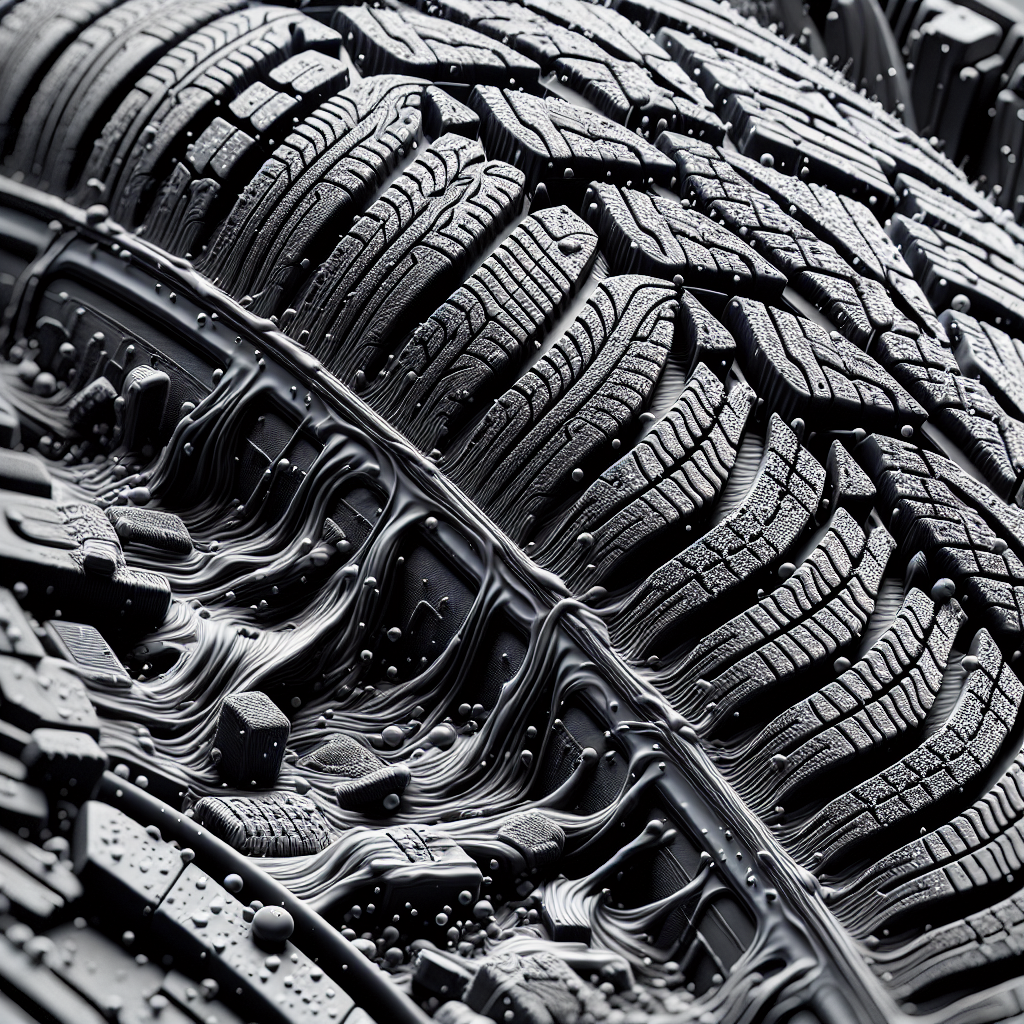Imagine zooming down the road with the wind in your hair and the freedom of the open road beckoning you forward. You’re enjoying the journey until suddenly, you need to slam on the brakes. But have you ever wondered how tire pressure can impact your braking performance? It turns out that the amount of air in your tires plays a crucial role in how quickly and effectively you can bring your vehicle to a stop. In this article, we will explore the fascinating connection between tire pressure and braking performance, giving you key insights into how to ensure your safety on the road.

The Basics of Tire Pressure
What is tire pressure?
Tire pressure refers to the amount of air inside a tire, measured in pounds per square inch (PSI). It is the pressure exerted by the air on the inner walls of the tire. Maintaining the proper tire pressure is crucial for optimal vehicle performance, including braking.
Why is tire pressure important?
Tire pressure plays a vital role in ensuring your safety while driving. Properly inflated tires ensure better handling, stability, and fuel efficiency. Additionally, sufficient tire pressure promotes even tread wear and extends the lifespan of your tires. When it comes to braking, tire pressure directly affects braking performance, which can significantly impact your ability to stop safely and quickly.
How is tire pressure measured?
To measure tire pressure, you’ll need a tire pressure gauge. Simply remove the valve cap from the tire, firmly press the gauge onto the valve, and read the pressure displayed on the gauge. It is recommended to measure the tire pressure when the tires are cold, as driving heats up the tires and may result in inaccurate readings.
Recommended tire pressure
The recommended tire pressure can usually be found in your vehicle’s owner’s manual or on a sticker located on the driver’s side doorjamb. The proper pressure varies depending on the vehicle make and model, as well as the tire size. It is important to adhere to the manufacturer’s recommendations to ensure optimal braking performance.
Understanding Braking Performance
What is braking performance?
Braking performance refers to the ability of a vehicle to decelerate effectively and safely when the brakes are applied. It encompasses various factors such as stopping distance, traction, and stability. Maintaining proper braking performance is essential for avoiding accidents and ensuring the safety of both you and others on the road.
Factors affecting braking performance
Several factors can impact braking performance, including tire condition, brake system effectiveness, road surface conditions, and driver reaction time. Among these factors, tire pressure plays a crucial role in determining the overall effectiveness of your brakes. By maintaining the appropriate tire pressure, you can positively influence your vehicle’s braking capabilities.
Importance of maintaining proper braking performance
Proper braking performance is vital for safe driving, as it significantly reduces the risk of accidents. When your vehicle’s brakes are operating at their best, you can react quickly to unexpected situations and bring the vehicle to a stop in the shortest distance possible. By prioritizing braking performance and regularly checking your tire pressure, you can enhance your vehicle’s safety and your peace of mind on the road.
Effects of Underinflated Tires on Braking Performance
Increased stopping distance
Underinflated tires have reduced contact with the road surface, resulting in an extended stopping distance. When the tire pressure is too low, the tire’s sidewalls bend excessively, creating a larger contact patch and increasing the rolling resistance. This increased resistance requires more force to slow down the vehicle, ultimately leading to longer braking distances.
Reduced traction
Traction is crucial for effective braking, especially in emergency situations. Underinflated tires have a smaller footprint, reducing the grip between the tire and the road. Without sufficient traction, the tires are more likely to skid or slide when braking, compromising your ability to maintain control of the vehicle.
Unstable braking
Underinflated tires can negatively affect the stability of your vehicle during braking. When the pressure is too low, the tire sidewalls flex excessively, causing the tire to deform and become less responsive to steering inputs. This can lead to a loss of control, making it more challenging to brake safely and maneuver the vehicle.
Risk of tire blowouts
Running your tires at low pressure for extended periods increases the risk of a tire blowout. The excessive flexing of the tire sidewalls generates heat, which can cause the rubber to degrade and weaken over time. A blowout while braking can be extremely hazardous, as it can result in loss of control and cause a serious accident. Regularly checking and maintaining proper tire pressure can help mitigate this risk.
Effects of Overinflated Tires on Braking Performance
Decreased contact patch
Overinflated tires have a smaller contact patch, as the center of the tread bulges outward due to the increased pressure. This reduced contact area limits the tire’s ability to grip the road surface effectively during braking. Less contact with the road leads to reduced traction and compromises the overall braking performance of the vehicle.
Reduced grip
When tires are overinflated, the tire’s tread becomes harder and less pliable. This can result in reduced grip and traction, particularly in emergency braking situations. The lack of flexibility in the tire’s tread prevents it from conforming to the road surface, leading to a decreased ability to grip and effectively slow down the vehicle.
Increased stopping distance
Similar to underinflated tires, overinflated tires require a longer distance to come to a complete stop. The reduced contact patch and diminished grip contribute to decreased braking performance. With less traction, the tires struggle to generate sufficient friction to slow down the vehicle efficiently, resulting in an increased stopping distance.
Unpredictable handling
Overinflated tires can negatively affect the handling of your vehicle, especially during braking maneuvers. The lack of grip and reduced contact area with the road can make the vehicle more difficult to control. This can lead to unpredictable handling characteristics, making it challenging to maintain stability and avoid potential accidents.

Impact of Tire Pressure on Braking Distance
Relationship between tire pressure and braking distance
The relationship between tire pressure and braking distance is straightforward: higher tire pressure can increase braking distance, while lower tire pressure can also negatively impact the stopping distance. By correctly inflating your tires to the recommended pressure, you can optimize braking performance and minimize the distance required to come to a stop.
Tests and studies on braking distance
Numerous tests and studies have been conducted to analyze the impact of tire pressure on braking distance. These tests involve controlled conditions and measurements to determine the differences in stopping distances with various tire pressures. The results consistently show that maintaining the proper tire pressure significantly improves braking distance and enhances overall safety.
Optimal tire pressure for improved braking performance
To achieve optimal braking performance, it is crucial to inflate your tires to the manufacturer’s recommended pressure. This information can be found in your vehicle’s owner’s manual or on the driver’s side doorjamb. By adhering to the recommended tire pressure, you can ensure that your vehicle’s brakes function efficiently and provide the shortest stopping distance possible.
Tire Pressure and Traction
Importance of traction in braking
Traction is the key to effective braking. When you apply the brakes, the tires must grip the road to slow down the vehicle safely and quickly. Without sufficient traction, your ability to control the vehicle during braking will be compromised, increasing the likelihood of accidents or loss of control.
How tire pressure affects traction
Tire pressure has a direct impact on traction. Properly inflated tires maintain a larger and more even contact patch with the road surface. This maximizes the tire’s ability to grip the road, especially during braking, and provides the necessary friction to slow down the vehicle effectively. With inadequate tire pressure, the contact patch reduces, compromising traction and impacting braking performance.
Tire grip and braking efficiency
Tire grip is closely related to braking efficiency. When the tires have optimal grip, they can effectively transfer the braking force to the road, allowing the vehicle to slow down quickly. The friction generated between the tire and the road plays a crucial role in this process. By maintaining the appropriate tire pressure, you can ensure that your tires have the necessary grip to brake efficiently and keep you safe on the road.

Braking Performance in Wet and Dry Conditions
Differences in braking performance on wet and dry roads
Braking performance can vary significantly between wet and dry road conditions. Wet roads introduce additional challenges, such as reduced traction and increased braking distances. The presence of water on the road surface reduces the tire’s grip, making it more difficult to slow down the vehicle effectively. Understanding these differences is essential for maintaining safe braking performance in various weather conditions.
Effect of tire pressure on wet braking
Tire pressure has a more pronounced impact on braking performance in wet conditions. Wet roads already diminish the tire’s ability to grip the surface due to reduced friction caused by water. Underinflated tires exacerbate this issue by further reducing the contact patch and compromising the tire’s grip. Properly inflated tires allow for better water evacuation and help maintain maximum traction during wet braking.
Effect of tire pressure on dry braking
While tire pressure is still significant for dry braking, it often has a relatively smaller impact compared to wet braking. In dry conditions, the overall grip and traction of the tire are usually better, even with slight variations in tire pressure. However, maintaining the correct tire pressure remains essential to ensure consistent braking performance and optimal control, particularly in emergency situations.
Performance of Different Tire Types
Effects of tire pressure on performance tires
Performance tires are designed to deliver enhanced grip, responsiveness, and handling. Proper tire pressure is crucial to achieve optimal performance from these tires. Underinflation can negatively impact the tire’s ability to flex and conform to the road surface, diminishing the tire’s high-performance characteristics. Conversely, overinflation can lead to a harsh and rigid ride, compromising both comfort and performance.
Effects of tire pressure on all-season tires
All-season tires are designed to provide adequate performance in a wide range of driving conditions. Maintaining the appropriate tire pressure is essential for maximizing the tire’s versatility. Proper tire pressure helps ensure even wear, consistent performance, and improved braking capabilities. By following the manufacturer’s recommended pressure, you can optimize the performance of your all-season tires.
Effects of tire pressure on winter tires
Winter tires are specifically designed to provide superior traction and grip in cold weather, ice, and snow. Proper tire pressure is crucial for these tires to perform effectively. Underinflated winter tires reduce their ability to bite into the snow or ice, resulting in compromised traction and handling. Overinflation can make the tire rigid, reducing its ability to conform to the road surface and decreasing traction.
Effects of tire pressure on off-road tires
Off-road tires are designed to tackle rugged terrains with enhanced traction and durability. Maintaining the proper tire pressure is crucial for off-road performance. Lowering the tire pressure for off-roading allows for better grip and improved flotation on uneven surfaces. However, it is important to return the tire pressure to the recommended level for regular on-road driving to ensure optimal braking performance and tire longevity.

Diagnosing Braking Issues Related to Tire Pressure
Signs of underinflated or overinflated tires
Several signs can indicate that your tires are either underinflated or overinflated. Underinflated tires often show signs of excessive wear on the edges, poor fuel efficiency, and vehicle handling issues. Overinflated tires may exhibit center tread wear, a harsh ride, and decreased traction. Regularly inspecting your tires for these signs can help identify potential tire pressure issues.
Symptoms of poor braking performance
Poor braking performance can manifest in various ways. If you notice longer braking distances, a spongy or unresponsive brake pedal, or a decrease in overall braking efficiency, it may indicate an issue with your tire pressure. It is essential to address these symptoms promptly by checking and adjusting your tire pressure as necessary.
How to check and adjust tire pressure
Checking and adjusting tire pressure is a simple process that can be done at home or at a service station. Start by using a tire pressure gauge to measure the current pressure of each tire. Compare the readings to the recommended pressure provided by the vehicle manufacturer. If adjustments are necessary, use an air compressor to add or release air until the correct pressure is achieved. Remember to check the pressure again after making adjustments to ensure accuracy.
When to seek professional assistance
If you feel unsure about checking or adjusting your tire pressure, it is best to seek professional assistance. Professional technicians at automotive service centers can accurately measure and adjust tire pressure to ensure optimal braking performance. They can also inspect the tires for any signs of damage or tread wear, providing you with peace of mind and expert advice.
Tips for Maintaining Optimal Tire Pressure
Regularly check tire pressure
Regular tire pressure checks are crucial for maintaining optimal braking performance. It is recommended to check your tire pressure at least once a month or before embarking on a long journey. By making this a habit, you can quickly identify and address any tire pressure issues, ensuring your safety and enhancing your vehicle’s overall performance.
Influence of temperature changes on tire pressure
Temperature changes can affect tire pressure. As the temperature drops, tire pressure tends to decrease, and in warmer temperatures, tire pressure tends to rise. It is important to take these fluctuations into account and regularly monitor your tire pressure to ensure it remains within the recommended range. Adjustments may be necessary during extreme temperature changes to maintain optimal tire pressure.
Importance of proper inflation
Proper tire inflation is essential for optimal braking performance. By maintaining the correct tire pressure, you can ensure that your tires have sufficient contact with the road surface, maximizing grip and traction during braking. Additionally, correct inflation contributes to even tread wear and extends the lifespan of your tires, saving you money in the long run.
Avoiding overinflation and underinflation
Both overinflation and underinflation should be avoided. Overinflated tires compromise grip and traction, negatively impacting braking performance. Conversely, underinflated tires increase stopping distances and reduce stability, posing a risk to your safety. By adhering to the recommended tire pressure, you can enjoy improved braking performance and enhance your driving experience.
In conclusion, tire pressure plays a crucial role in braking performance. Properly inflated tires ensure maximum grip, traction, and stability, reducing stopping distances and minimizing the risk of accidents. Understanding the effects of underinflated and overinflated tires on braking performance is key to maintaining safe and efficient braking. By regularly checking and adjusting tire pressure, you can optimize your vehicle’s performance, enhance your braking capabilities, and ensure a safer driving experience for yourself and others on the road.


